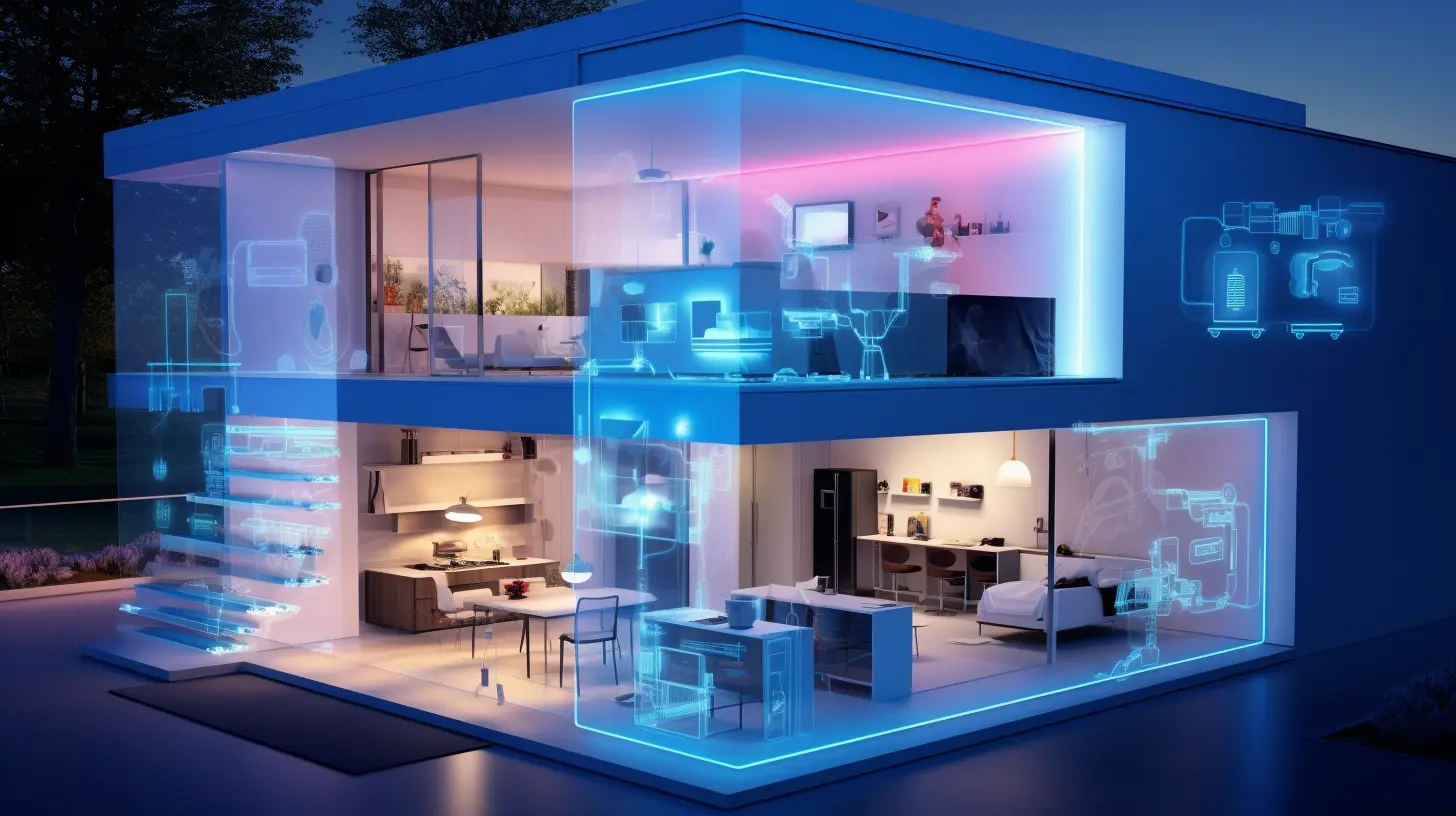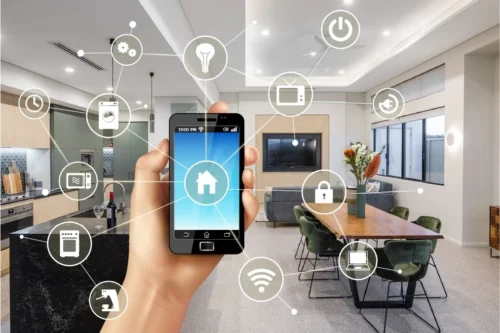The Future of Living: Innovative Smart Home Design
Imagine stepping into a home where every corner is seamlessly connected, responding to your needs before you ask. Welcome to the future of living, where incorporating smart home design transforms ordinary spaces into extraordinary experiences. From lighting that adjusts to your mood to thermostats that learn your preferences and security systems that keep your home safe 24/7, smart technology in interiors is revolutionizing the way we interact with our environments.
Dive into the world of Smart Home Design, where innovation meets convenience, and discover how these advanced solutions can elevate your lifestyle to new heights.
The Smart Home Experience: Merging Design with Technology.
Key Areas of Smart Home Design
Smart Home Design can transform a living space into a highly efficient, convenient, and interconnected environment. Important aspects in this field can be mentioned:
- Home Automation Systems: That allows for centralized control of various home functions, often through a smartphone or voice command.
- Smart Lighting: These systems can be controlled remotely, set to schedules, or adjusted based on ambient conditions.
- Climate Control: Smart devices that regulate heating, ventilation, and air conditioning (HVAC) systems for comfort and energy efficiency.
- Security Systems: Technology designed to enhance home security through monitoring and alerting systems.
- Entertainment Systems: Devices and systems that enhance home entertainment experiences through integration and automation.
- Energy Management: Systems designed to monitor and optimize energy consumption in the home.
- Kitchen and Appliance Integration: Smart devices and appliances are designed to improve functionality and convenience in the kitchen.
- Health and Wellness: Devices that monitor and enhance the well-being of residents.
|
Category |
Devices/Systems |
Functions |
|
Home Automation |
Smart Hubs, Smart Plugs |
Centralized Control, Remote Management |
|
Smart Lighting |
Smart Bulbs, Smart Switches |
Remote Control, Adjustable Brightness & Color |
|
Climate Control |
Smart Thermostats, Smart Air Purifiers |
Temperature Regulation, Air Quality Monitoring |
|
Security Systems |
Smart Cameras, Smart Locks |
Surveillance, Remote Locking & Unlocking |
|
Entertainment Systems |
Smart TVs, Smart Speakers |
Streaming, Voice Control, Multi-Room Audio |
|
Energy Management |
Smart Meters, Solar Panel Integration |
Energy Consumption Monitoring, Solar Energy Management |
|
Kitchen Appliances |
Smart Refrigerators, Smart Ovens |
Inventory Management, Remote Cooking Control |
|
Health And Wellness |
Smart Sleep Trackers, Smart Water Purifiers |
Sleep Monitoring, Water Quality Assurance |
Benefits of Smart Home Design in Interiors
Integrating Smart Home Design not only enhances functionality and aesthetics but also contributes to a more connected and efficient living environment:
- Convenience: Simplifies daily routines with automation and remote control.
- Energy Efficiency: Reduces energy consumption through optimized usage and smart management.
- Enhanced Comfort: Tailors the environment to personal preferences with customizable settings.
- Increased Security: Provides better monitoring and control over home security.
- Considerations Compatibility: Ensure devices are compatible with each other and with central control systems.
- Privacy and Security: Implement strong security measures to protect against unauthorized access.
- Cost: Evaluate the investment versus the benefits and consider gradual implementation.
Innovative Design for Intelligent Homes.
From Concept to Reality: Smart Home Design Essentials
Imagine a home where your everyday tasks become effortlessly simple and your living space adapts to your every need. Welcome to the realm of home automation ideas, where cutting-edge technology meets convenience to transform your living experience.
Smart Home Design involves integrating various smart technologies to manage and control home systems and devices more efficiently. The home automation ideas enhance convenience, comfort, and efficiency by leveraging technology to create a more responsive and intelligent living environment. With these smart solutions, you can transform your home into a highly functional and adaptive space tailored to your needs and preferences.

Smart Home Aesthetics: Balancing Style and Functionality.
Seamless Living: Integrating Technology into Smart Home Design
Here’s a comprehensive look at some innovative home automation ideas in interiors:
1. Smart Lighting Systems:
- Automated Schedules: Program lights to turn on and off at specific times or based on occupancy.
- Voice Control: Use voice assistants like Amazon Alexa or Google Assistant to adjust lighting.
- Scene Setting: Create lighting scenes for different activities such as reading, dining, or relaxing.
2. Smart Thermostats and Climate Control:
- Adaptive Learning: Thermostats learn your schedule and adjust heating or cooling for efficiency.
- Remote Control: Manage temperature settings via smartphone apps.
- Zoned Heating/Cooling: Control different areas of the home independently for customized comfort.
3. Security Systems in Smart Home Design:
- Video Surveillance: Monitor live feeds and record footage with smart cameras.
- Smart Locks: Lock or unlock doors remotely and track entry/exit logs.
- Motion Sensors: Get alerts when movement is detected in specific areas.
4. Home Entertainment Automation:
- Multi-Room Audio: Sync music across multiple rooms with smart speakers.
- Streaming Integration: Control smart TVs and streaming devices with voice commands or apps.
- Automated Media Systems: Create movie or music setups that adjust lighting, sound, and screen settings automatically.
5. Smart Kitchen Appliances:
- Remote Cooking: Preheat ovens, start coffee makers, or check fridge contents remotely.
- Voice Commands: Operate appliances with voice assistants.
- Inventory Management: Track food inventory and receive notifications about expiration dates.
6. Automated Window Treatments:
- Scheduled Opening/Closing: Program blinds or shades to open and close based on time of day or sunlight.
- Remote Control: Adjust window treatments via smartphone apps or voice commands.
- Integration: Sync with other systems like lighting and climate control for a cohesive environment.
7. Smart Home Hubs and Controllers:
- Centralized Management: Control various smart devices from a single hub or app.
- Automation Routines: Set up routines that trigger multiple actions, such as “Good Morning” routines that adjust lighting, temperature, and start the coffee maker.
- Voice Assistants: Use devices like Amazon Echo or Google Nest Hub for voice-controlled automation.
8. Smart Home Design Health and Wellness:
- Sleep Monitoring: Track sleep patterns and adjust bedroom conditions for optimal rest.
- Air Quality Monitoring: Monitor and improve indoor air quality with smart sensors and purifiers.
- Water Usage Tracking: Monitor and manage water consumption to detect leaks and save on utility bills.
9. Energy Management Systems:
- Smart Meters: Track and analyze energy consumption to optimize usage.
- Solar Integration: Monitor solar panel performance and manage energy storage.
- Automated Controls: Automatically adjust energy use based on occupancy and weather conditions.
Implementation Considerations of Smart Home Design
The smart home design not only enhances convenience and comfort but also contributes to energy efficiency and security. As technology evolves, staying updated with the latest innovations can further improve home living experiences. When smart technology is in interiors, attention to Compatibility. Ensure devices and systems work together seamlessly. Implement strong security measures, such as strong passwords and encryption, to protect against hacking and unauthorized access. Design should prioritize ease of use. Consider how users interact with the technology and aim for intuitive interfaces. Smart Home Design can be expensive. Assess the cost versus the benefits and consider gradual integration based on budget and needs.
